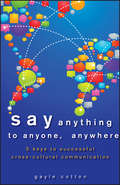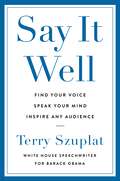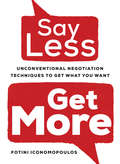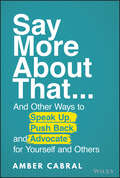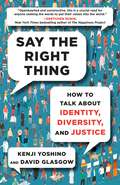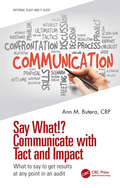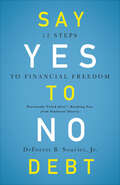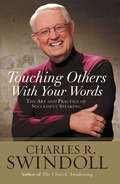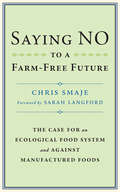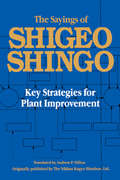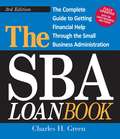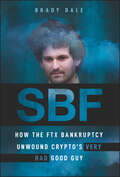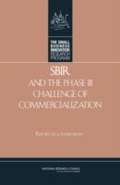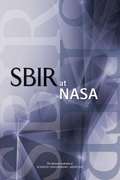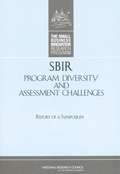- Table View
- List View
Saxonville Sausage
by Kate MooreSaxonville Sausage, a $1.5 billion manufacturer of pork sausage products, is experiencing financial stress because its leading product lines have lately produced declining revenues in product categories that are realizing no growth. However, one product line, an Italian sausage brand named Vivio, has recently experienced a significant increase in revenues, as has the entire Italian sausage category nationwide. Unfortunately, Vivio represents only 5% of the company's total revenues. Ann Banks, a seasoned marketing director, has been hired to expand Vivio, currently distributed in a few cities, especially in the northeastern U.S, into a powerful national brand. Depicts the sequence of steps Ann takes to determine the best positioning for the brand. These steps include analyzing and employing specific techniques for researching customers' needs, preferences, and values; using the learning from research to develop a motivation-centered characterization of the target consumer; eliciting tactical ideas from a cross-departmental team of colleagues for product "alterations," packaging, and other contributory elements in the branding program; and finally, choosing between two positionings that seem equally valid.
Say Anything to Anyone, Anywhere: 5 Keys To Successful Cross-Cultural Communication
by Gayle CottonThe five steps to successful selling, negotiating, and managing multi-culturally Say Anything to Anyone, Anywhere gives readers five simple key guidelines to create rapport and organize strategies for success across different cultures.<P><P> This book teaches to be proactive, not reactive, in your cross-cultural communications and shows how to use simple rapport tools to create trust with the cultures you work with or travel to. Learn how to organize productive interactions in person, on the phone, and by email. Discover interpersonal communication skills and virtual strategies that build strong relationships. Offers quick, accessible examples and clear guidelines about how to create an understanding between cultures Gives tips and strategies on how to communicate without offending Author Gayle Cotton is a Emmy Award Winner and a distinguished, highly sought after speaker, corporate trainer, and executive coach. This step-by-step guide to cross-cultural business will help you build strong relationships and manage successfully, no matter the cultural differences.
Say it and Live it: The 50 Corporate Mission Statements that Hit the Mark
by Patricia Jones Larry KahanerSay It And Live It is the first collection of provocative, passionate, and intelligent corporate mission statements--the most powerful and popular managerial tool in business today. A corporate mission statement is the most dramatic presentation of a company's vision and its goal. No other document--annual report, press release, news article, statement from the board of directors--tells us more about a company's values and ethics than a mission statement. Companies know that if they write it down, they will have to live up to it--so they devote months, even years, the energy of people from the CEO on down, and significant sums of money to crafting them. Say It And Live It is the only source of information for the many business people who are presently writing their own mission statements. In it, authors Patricia Jones and Larry Kahaner show that industry leaders are frequently corporations that truly live their mission statements. Some of the winners include: Avis, Ben & Jerry's, Boeing, Citicorp, General Electric, Gillette, Hallmark Cards, IBM, Kellogg's, Reader's Digest, Saturn, Southwest Airlines, UPS, and Xerox. Say It And Live It is a collection of the fifty best corporate mission statements in America. Each entry consists of the company's complete mission statement, along with an explanation of how it was written, a lesson about how that mission statement saved the company or motivated employees, or comments from the CEO or the president. The introduction points out the common elements of these philosophical documents, while the final chapter is a list of tips on how you can write your own mission statement.
Say It Well: Find Your Voice, Speak Your Mind, Inspire Any Audience
by Terry SzuplatOne of Barack Obama’s longest-serving speechwriters reveals the public speaking lessons that will help you become a more confident and compelling communicator and leader.As a White House speechwriter, Terry Szuplat helped craft hundreds of speeches for President Obama. But when it came to public speaking himself, Szuplat—like many people—was gripped by anxiety and preferred to stay in the shadows. When he was invited to give the first major speech of his life, he faced a choice: keep hiding from what scared him, or finally face his fears.In Say It Well, Szuplat shares the life-changing lessons he learned from Barack Obama—one of the most admired speakers of our time—and how he applied these techniques to become a better speaker himself. In every chapter, he shares never-before-heard advice from Obama on speaking well, along with riveting behind-the-scenes stories of writing for a president—so you can master every step of public speaking, including:• Tips for overcoming stage fright• Best practices for using artificial intelligence to compose a memorable speech• Attention-grabbing openings to pull in any audience• Framing techniques to make your arguments more persuasive • Scientifically-proven ways to inspire people to action and to create the change you want• Tricks for editing, polishing, and practicing your words for maximum impact• The only way to end any great speechAlong the way, Szuplat introduces you to remarkable people from all walks of life—students, advocates, business executives, veterans—who have used these techniques to give speeches that have gone viral and inspired millions of people around the world. At a time of division and distrust, Say It Well also shows how we can all speak with the empathy, civility, and honesty that we need now more than ever.In sharing his journey to find his own voice, Szuplat will help you find yours. Written with humor and warmth, this is your new guide to the art of public speaking. And the next time you speak—whether you’re giving a toast or a eulogy for a loved one, a presentation at work, or an impassioned appeal for a cause you care about—not only will you know what to say, you’ll know how to say it well..
Say Less, Get More: Unconventional Negotiation Techniques to Get What You Want
by Fotini IconomopoulosNegotiation without fear, for everyone, everywhere Nicknamed “the negotiator” as a child, Fotini Iconomopoulos has been honing her skills her entire life. As a sought-after expert, for more than a decade she’s been empowering Fortune 500 executives and their teams to achieve their objectives, guiding them through high-stakes scenarios in industries such as consumer packaged goods, retail, professional services, energy, telecommunications, tech and finance. Now for the first time, Iconomopoulos shares her simple and innovative strategies, debunks common negotiation myths and explains why effective negotiation does not follow a one-size fits all/art of the deal approach. In Say Less, Get More you’ll find out how to: Assess where your situation falls on the negotiation spectrum so you can adjust your tactics accordinglyUnderstand who you are negotiating with, their background and their goals, in order to develop your approachDetermine your starting position, your final outcome and a strategy to get thereManage the negotiation process, overcome obstacles and find common groundCommunicate effectively in any scenario, including learning what to say and when to say it if you can’t reach a dealDevelop and foster excellent client relationships and networks Once you are armed with Iconomopoulos’s sensible strategies and proven advice, you’ll be able to confidently get what you want in business and in life.
Say More About That: ...And Other Ways to Speak Up, Push Back, and Advocate for Yourself and Others
by Amber CabralConcrete strategies to call out wrongdoing at home, at work, at school, and elsewhere In Say More About That, veteran inclusion strategist, coach, writer, and speaker Amber Cabral delivers an incisive and practical guide to assertively addressing inequitable treatment you see at home, work, school, and other settings. The book offers a complete communications toolkit for equity advocacy you can deploy on your own behalf and on behalf of others. You&’ll get the tactics, context, and tools that make being brave and speaking up a lot easier. You&’ll also find: A thorough discussion of the fundamentals of inclusion and equity, including concepts of advocacy and allyship, privilege, and identity An examination of the social landscape that makes speaking up so daunting Explorations of the most effective language and tactics you can use when you make a stand for yourself or others The perfect resource for underrepresented professionals, allies, advocates, and people seeking to make a positive difference in the world, Say More About That is the assertiveness manual you need if you&’ve been meaning to speak up but are worried about being drowned out.
Say on Pay: Qualcomm, Inc. Shareholders Vote 'Maybe' in 2012
by Suraj Srinivasan Kelly Baker Charles C.Y. WangThis case centers around Qualcomm shareholders' 2012 Say-on-Pay vote and the dispute between the Institutional Shareholder Services and management regarding the appropriateness of the CEO's compensation plan. Was ISS right that Qualcomm CEO's pay was inflated and justified by benchmarking to aspirational peers? Or was management correct that its CEO's pay is warranted by Qualcomm's recent firm performance?
Say on Pay: Qualcomm, Inc. Shareholders Vote 'Maybe'
by Charles C.Y. Wang Kelly Baker Suraj SrinivasanThis case centers around Qualcomm shareholders' 2012 Say-on-Pay vote and the dispute between the Institutional Shareholder Services and management regarding the appropriateness of the CEO's compensation plan. Was ISS right that Qualcomm CEO's pay was inflated and justified by benchmarking to aspirational peers? Or was management correct that its CEO's pay is warranted by Qualcomm's recent firm performance?
Say the Right Thing: How to Talk About Identity, Diversity, and Justice
by Kenji Yoshino David GlasgowA practical, shame-free guide for navigating conversations across our differences at a time of rapid social change.In the current period of social and political unrest, conversations about identity are becoming more frequent and more difficult. On subjects like critical race theory, gender equity in the workplace, and LGBTQ-inclusive classrooms, many of us are understandably fearful of saying the wrong thing. That fear can sometimes prevent us from speaking up at all, depriving people from marginalized groups of support and stalling progress toward a more just and inclusive society. Kenji Yoshino and David Glasgow, founders of the Meltzer Center for Diversity, Inclusion, and Belonging at NYU School of Law, are here to show potential allies that these conversations don&’t have to be so overwhelming. Through stories drawn from contexts as varied as social media posts, dinner party conversations, and workplace disputes, they offer seven user-friendly principles that teach skills such as how to avoid common conversational pitfalls, engage in respectful disagreement, offer authentic apologies, and better support people in our lives who experience bias. Research-backed, accessible, and uplifting, Say the Right Thing charts a pathway out of cancel culture toward more meaningful and empathetic dialogue on issues of identity. It also gives us the practical tools to do good in our spheres of influence. Whether managing diverse teams at work, navigating issues of inclusion at college, or challenging biased comments at a family barbecue, Yoshino and Glasgow help us move from unconsciously hurting people to consciously helping them.
Say What!? Communicate with Tact and Impact: What to say to get results at any point in an audit (Internal Audit and IT Audit)
by Ann M. ButeraThis book addresses the important role of communication within the context of performing an audit, project, or review (i.e., planning, detailed testing, and reporting). Intended for audit, information security, enterprise, and operational risk professionals at all levels, including those just starting out, Say What!? Communicate with Tact and Impact: What to Say to Get Results at Any Point in an Audit contains an array of practical and time-tested approaches that foster efficient and effective communication at any point during an engagement. The practical and memorable techniques are culled from author Ann M. Butera’s CRP experience as a trusted advisor who has taught thousands of professionals how to develop and hone their interpersonal, communication, and empathic skills. Those familiar with the Five Tier Competency ModelTM she developed will recognize these techniques as a deep dive on the competencies comprising Tier 3: Project Management and Tier 5: Managing Constituent Relations. The author discusses the following behaviors in one’s dealings with executives, process owners, control performers, and colleagues: Demonstrating executive presence Becoming the trusted advisor Influencing others Communicating with tact, confidence, and impact Facilitating productive meetings and discussions Overcoming resistance and objections Managing and resolving conflict Knowing when to let a topic go and move on This book is a guide for professionals who want to interact proactively and persuasively with those they work with, audit, or review. It describes techniques that can be used during virtual, in-person, telephone, or video conferences (as opposed to emails, workpapers, and reports). It provides everyone (newer associates in particular) with the interpersonal skills needed to (1) develop and build relationships with their internal constituents and clients, (2) facilitate conversations and discussions before and during meetings, and (3) handle impromptu questions with confidence and executive presence and make positive first impressions. The topics and techniques discussed are accompanied by case studies, examples, and exercises to give the readers the opportunity to develop plans to bridge the gap between theory and practice. The readers can use the book as a reliable resource when subject matter experts or training guides are not readily available.
Say Yes to No Debt: 12 Steps to Financial Freedom
by DeForest B. Soaries Jr.The founder of the dfree™ movement's twelve attainable steps to financial freedom. This book is not just another financial literacy program that assumes that all people need is information. Drawing on his personal experience and years as a pastor, public policy maker, and community leader, DeForest "Buster" Soaries, Jr. shares a groundbreaking, life-changing approach to financial wellness that views financial bondage as an emotional, spiritual, and psychological problem.The dfree™ movement provides twelve easy, attainable steps to help you:Get started on your debt by admitting the problem, addressing the mess, and adjusting your attitudeGet control by creating a spending plan, becoming accountable, and setting goalsGet ahead by building wealth, planning your will and estate, and celebrating your successAnd give back by investing in others, through tithing, mentoring, and leading your own dfree™ movementIf you want to live a debt-free life with the financial freedom to travel, purchase a home within your means, and enjoy retirement without the burden of pay excess monthly bills, then this book is for you.Eliminating debt is the first step toward financial freedom. And YOU can do it.
Say Yes When Life Says No
by Dr. DeForest B. Soaries Jr.Many people understand what it feels like when life continually throws obstacles, prejudice, hardship, and economic challenge in what seems an endless string of misfortune. It can feel like life constantly challenges us with “no” in the form of:LonelinessJudgmentNegativitySicknessDeath, and moreBut when we draw on the same faith as the blind man in John Chapter 9, we learn to trust that Jesus will know our plight, show up and give us what we need to not only turn our life course, but to also have our hearts sing “yes!”Drawn from the remarkable life experiences of one man, Say Yes When Life Says No includes a first-hand account of Rev. Dr. DeForest Soaries – pastor, husband, father, public servant, and cancer survivor. Enriched with personal stories and vivid Biblical references, Dr. Soaries provokes us to see every obstacle in life as an opportunity and every burden as a potential blessing.
Saying It Well: Touching Others with Your Words
by Charles R. SwindollBestselling author and master communicator Charles Swindoll has been effectively speaking to others for over fifty years. In SAYING IT WELL: Touching Others With Your Words he shares his secrets on how to talk so people will listen. Filled with techniques, stories, and models that clearly explain the formulas for successful speaking, Swindoll teaches readers the foundational principles for how to communicate, from preparing for a speech, organizing thoughts, and filtering out the superfluous to overcoming fears, grabbing the listener's attention, and knowing how and when to stop. With humorous stories and inventive, practical tips, one of America's premier communicators shares decades of experience on how to speak with authority in every situation, persuade others to consider the reader's perspective, overcome the reader's fears of public speaking, and love others more effectively with the reader's words. He also shares his personal story and the journey to becoming a world-famous speaker.nner...and frankly, how and when to stop. The book will be written for professional speakers and pastors as well as regular people who may be teachers or in a business who are called on from time to time to deliver a verbal presentation. With humorous stories and inventive, practical tips, one of America's premier communicators shows the reader how to speak with authority in every situation, persuade others to consider the reader's perspective, overcome the reader's fears of public speaking, and love others more effectively with the reader's words.
Saying NO to a Farm-Free Future: The Case For an Ecological Food System and Against Manufactured Foods
by Chris Smaje“Everyone in the food business needs to read this book. . . . [A] lively and superbly written polemic.”—Joel Salatin, co-founder of Polyface Farm A defense of agroecological, small-scale farming and a robust critique of an industrialized future. One of the few voices to challenge The Guardian's George Monbiot on the future of food and farming (and the restoration of nature) is academic, farmer and author of A Small Farm Future Chris Smaje. In Saying NO to a Farm-Free Future, Smaje presents his defense of small-scale farming and a robust critique of Monbiot’s vision for an urban and industrialized future. Responding to Monbiot’s portrayal of an urban, high-energy, industrially manufactured food future as the answer to our current crises, and its unchallenged acceptance within the environmental discourse, Smaje was compelled to challenge Monbiot’s evidence and conclusions. At the same time, Smaje presents his powerful counterargument – a low-carbon agrarian localism that puts power in the hands of local communities, not high-tech corporates. In the ongoing fight for our food future, this book will help you to understand the difference between a congenial, ecological living and a dystopian, factory-centered existence. A must-read! "Chris Smaje has laid down an indictment – as unremitting as it is undeniable – that cuts through the jargon-filled, techno-worshipping agricultural futurists who promise silver-bullet fixes for having your cake and eating it too. This brilliant and compelling book is at once hopeful and persuasive about the future of food."—Dan Barber, chef at Blue Hill and author of The Third Plate
The Sayings of Shigeo Shingo: Key Strategies for Plant Improvement
by Shigeo ShingoHere is a great introduction to the remarkable mind of Shigeo Shingo, indisputably one of the great forces in manufacturing. In this soft cover book, Dr. Shingo describes his approach to manufacturing improvements, developed and refined over the course of a brilliant career. He called it the Scientific Thinking Mechanism (STM). The Sayings of Shigeo Shingo leads you through the five stages of STM, with appropriate examples taken from notes Dr. Shingo collected during his consulting trips to American and Japanese plants. It shows how, in many cases, the most brilliant ideas are often so simple they're overlooked. Or they're dismissed because they seem ridiculous: - A Japanese plant, after first rejecting the idea as too silly, finds that unhulled rice is ideal for smoothing the rough surfaces on pressure-formed ebonite switches - Granville-Phillips, in Boulder, Colorado, reduced defects to zero in one process after Dr. Shingo suggested illuminating circuit boards from below to reduce errors involved in the insertion of diodes and resistors The Sayings of Shigeo Shingo is must reading for plant managers and engineers. It formalizes the powerful and creative way of thinking that Shingo himself used time and again to overcome problems that seemed virtually insurmountable.
The Sayings of Shigeo Shingo: Key Strategies for Plant Improvement
by Shigeo ShingoHere is a great introduction to the remarkable mind of Shigeo Shingo, indisputably one of the great forces in manufacturing. In this book Dr. Shingo describes his approach to manufacturing improvements, developed and refined over the course of a brilliant career. He called it the Scientific Thinking Mechanism (STM).The Sayings of Shigeo Shingo leads you through the five stages of STM, with appropriate examples taken from notes Dr. Shingo collected during his consulting trips to American and Japanese plants. It shows how, in many cases, the most brilliant ideas are often so simple they're overlooked. Or they're dismissed because they seem ridiculous:A Japanese plant, after first rejecting the idea as ""too silly,"" finds that unhulled rice is ideal for smoothing the rough surfaces on pressure-formed ebonite switchesGranville-Phillips, in Boulder, Colorado, reduced defects to zero in one process after Dr. Shingo suggested illuminating circuit boards from below to reduce errors involved in the insertion of diodes and resistorsThe Sayings of Shigeo Shingo is must reading for plant managers and engineers. It formalizes the powerful and creative way of thinking that Shingo himself used time and again to overcome problems that seemed virtually insurmountable.
The SBA Loan Book
by Charles H. GreenSpurred by President Obama, the Small Business Association has stepped up its loan program to companies around the nation. But to receive an SBA-guaranteed loan, firms must navigate a complex course of processes, qualifications, documentation, and approvals.You need this new edition of Charles Green's invaluable book to chart the best way to apply for and get an SBA loan. Green wastes no time in showing: Why an SBA loan guarantee is a good option in tough economic timesHow to choose the right bank at a time when many banks have failed and credit is tightWhat the new rules and regulations say about the paperwork and documentation loan applicants must supplyIn today's turbulent economic climate, solid financial backing is the key to small business survival. And this fully updated guide to SBA loans will help you land it.
The SBA Loan Book: The Complete Guide to Getting Financial Help Through the Small Business Administration
by Charles H GreenSpurred by President Obama, the Small Business Association has stepped up its loan program to companies around the nation. But to receive an SBA-guaranteed loan, firms must navigate a complex course of processes, qualifications, documentation, and approvals.You need this new edition of Charles Green's invaluable book to chart the best way to apply for and get an SBA loan. Green wastes no time in showing:Why an SBA loan guarantee is a good option in tough economic timesHow to choose the right bank at a time when many banks have failed and credit is tightWhat the new rules and regulations say about the paperwork and documentation loan applicants must supplyIn today's turbulent economic climate, solid financial backing is the key to small business survival. And this fully updated guide to SBA loans will help you land it.
The SBA LOAN BOOK 3rd Edition
by Charles H. GreenToday, more businesses than ever before are seeking loans backed by the Small Business Association. But to receive an SBA-guaranteed loan, you'll have to successfully navigate a series of complex qualifications, documentation, and approvals. The newest edition of Charles Green's invaluable guide will help you find the best loan for your business and assemble all the documentation you'll need to get it. Inside, he breaks down: Why an SBA loan guarantee is a good option in a tough economy How to choose the right bank at a time when many banks have failed and credit is tight What the new rules and regulations say about the paperwork and documentation you must supply Solid financial backing is the key to small business survival. This fully updated guide to SBA loans takes the guesswork out of a complicated application process and increases your odds of securing the money you need.
SBF: How The FTX Bankruptcy Unwound Crypto's Very Bad Good Guy
by Brady DaleA first-hand look at the extraordinary collapse of FTX, Alameda Research, and Sam Bankman-Fried In SBF: How the FTX Bankruptcy Unwound Crypto’s Very Bad Good Guy, accomplished crypto reporter Brady Dale presents an engrossing take on the spectacular and sudden implosion of FTX, Alameda Research, and their associated companies, as well as the criminal indictments of Sam Bankman-Fried and several of his associates. In the book, you’ll go beyond the salacious details and tawdry gossip to grasp the real lessons to be learned from one of the most dramatic corporate failures in living memory. The author explores: The often-confusing world of cryptocurrency and decentralized finance, offering a deep understanding of both industries The history of Sam Bankman-Fried, what smart money players had to say about him in 2019 and 2020, and why many decentralized finance professionals considered him a “pirate” even before FTX and Alameda blew up What the aggressive lobbying campaigns waged by FTX and Sam Bankman-Fried reveal about the latter’s motives and goalsAn extraordinary account of almost unimaginable wealth, greed, and hubris, SBF is a can’t-miss account of a fascinating corporate tragedy that continues to unfold to this very day.
Sbir And The Phase Iii Challenge Of Commercialization: Report Of A Symposium
by National Research Council of the National AcademiesCommercialization of successful SBIR awards is a key challenge for the program and represents an essential step in the program’s contribution to government missions. To better understand the challenges inherent in the conversion of promising research to useful products and processes, the National Research Council convened a conference focused on the commercialization of SBIR-funded innovations at DoD and NASA. A unique feature of the conference is that it brought together, for the first time, the program managers, small business leaders, and prime contractor personnel involved in commercializing the results of SBIR awards through procurement at DoD and NASA. These participants identified the challenges and highlighted existing and evolving best practices among successful cases in the third (or commercialization) phase of the SBIR program. The conference, captured in this report, contributed significantly to a better understanding of the obstacles and opportunities in this phase of the SBIR program and to legislation designed to address these challenges.
SBIR at NASA
by Engineering Medicine National Academies of SciencesThe Small Business Innovation Research (SBIR) program is one of the largest examples of U.S. public-private partnerships, and was established in 1982 to encourage small businesses to develop new processes and products and to provide quality research in support of the U.S. government’s many missions. The U.S. Congress tasked the National Research Council with undertaking a comprehensive study of how the SBIR program has stimulated technological innovation and used small businesses to meet federal research and development needs, and with recommending further improvements to the program. In the first round of this study, an ad hoc committee prepared a series of reports from 2004 to 2009 on the SBIR program at the five agencies responsible for 96 percent of the program’s operations—including NASA. In a follow-up to the first round, NASA requested from the Academies an assessment focused on operational questions in order to identify further improvements to the program. Public-private partnerships like SBIR are particularly important since today's knowledge economy is driven in large part by the nation's capacity to innovate. One of the defining features of the U.S. economy is a high level of entrepreneurial activity. Entrepreneurs in the United States see opportunities and are willing and able to assume risk to bring new welfare-enhancing, wealth-generating technologies to the market. Yet, although discoveries in various fields present new opportunities, converting these discoveries into innovations for the market involves substantial challenges. The American capacity for innovation can be strengthened by addressing the challenges faced by entrepreneurs.
SBIR at the Department of Defense
by Committee on Capitalizing on Science Technology Innovation An Assessment Of The Small Busin Program—Phase IICreated in 1982 through the Small Business Innovation Development Act, the Small Business Innovation Research (SBIR) program remains the nation's single largest innovation program for small business. The SBIR program offers competitive awards to support the development and commercialization of innovative technologies by small private-sector businesses. At the same time, the program provides government agencies with technical and scientific solutions that address their different missions. "SBIR at the Department of Defense" considers ways that the Department of Defense SBIR program could work better in addressing the congressional objectives for the SBIR program to stimulate technological innovation, use small businesses to meet federal research and development (R & D) needs, foster and encourage the participation of socially and economically disadvantaged small businesses, and increase the private sector commercialization of innovations derived from federal R&D. An earlier report, "An Assessment of the Small Business Innovation Research Program at the Department of Defense," studied how the SBIR program has stimulated technological innovation and used small businesses to meet federal research and development needs. This report builds on the previous one, with a revised survey of SBIR companies. "SBIR at the Department of Defense" revisits some case studies from the 2009 study and develops new ones, and interviews agency managers and other stakeholders to provide a second snapshot of the program's progress toward achieving its legislative goals.
SBIR at the National Science Foundation
by Committee on Capitalizing on Science Technology Innovation An Assessment Of The Small Busin Program-Phase IIThe Small Business Innovation Research (SBIR) program is one of the largest examples of U. S. public-private partnerships, and was established in 1982 to encourage small businesses to develop new processes and products and to provide quality research in support of the U. S. government’s many missions. The U. S. Congress tasked the National Research Council with undertaking a comprehensive study of how the SBIR program has stimulated technological innovation and used small businesses to meet federal research and development needs, and with recommending further improvements to the program. In the first round of this study, an ad hoc committee prepared a series of reports from 2004 to 2009 on the SBIR program at the five agencies responsible for 96 percent of the program’s operations -- including the National Science Foundation (NSF). Building on the outcomes from the first round, this second round presents the committee’s second review of the NSF SBIR program’s operations. Public-private partnerships like SBIR are particularly important since today's knowledge economy is driven in large part by the nation's capacity to innovate. One of the defining features of the U. S. economy is a high level of entrepreneurial activity. Entrepreneurs in the United States see opportunities and are willing and able to assume risk to bring new welfare-enhancing, wealth-generating technologies to the market. Yet, although discoveries in areas such as genomics, bioinformatics, and nanotechnology present new opportunities, converting these discoveries into innovations for the market involves substantial challenges. The American capacity for innovation can be strengthened by addressing the challenges faced by entrepreneurs.
SBIR Program Diversity And Assessment Challenges: Report Of A Symposium
by Charles WessnerIn response to a Congressional mandate, the National Research Council conducted a review of the Small Business Innovation Research Program (SBIR) at the five federal agencies with SBIR programs with budgets in excess of $100 million (DOD, NIH, NASA, DOE, and NSF). The project was designed to answer questions of program operation and effectiveness, including the quality of the research projects being conducted under the SBIR program, the commercialization of the research, and the program's contribution to accomplishing agency missions. The first in a series to be published in response to the Congressional request, this report summarizes the presentations at a symposium convened at the beginning of the project. The report provides a comprehensive overview of the SBIR program’s operations at the five agencies responsible for 96 percent of the program’s operations.

